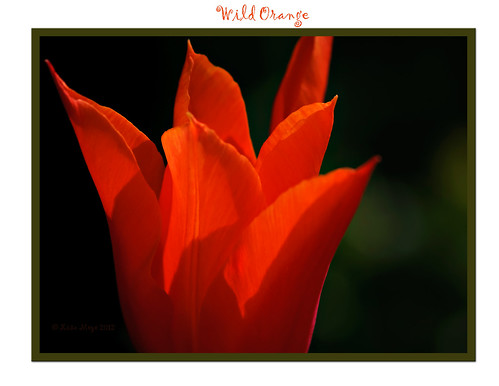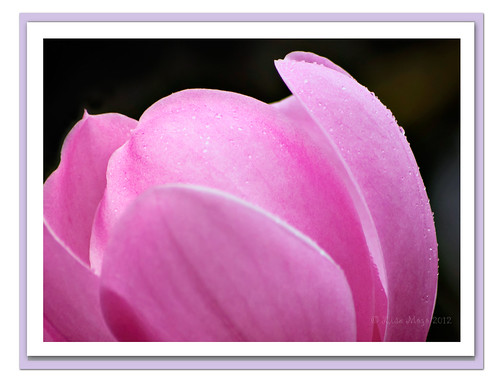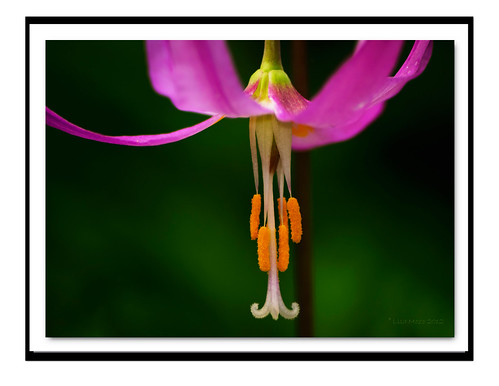Our Dreams
You belong to earth;
Therefore
You dream of fame and glory.
He belongs to Heaven;
Therefore
He dreams of love and service.
I belong to God;
Therefore
I dream of compassion and perfection. ~ Sri Chinmoy
Friday, 20 April 2012
Heavenly Blues ~
Wild Orange ~
Tulips are symbolic of fame and perfect love. The symbolic meanings also change with the color of the tulips. Red tulips mean "believe me" and are a declaration of true love. Variegated tulips mean "you have beautiful eyes." Yellow tulips mean "there's sunshine in your smile" and cheerful thoughts. Cream colored tulips mean "I will love you forever." White tulips symbolize heaven, newness and purity. Purple tulips symbolize royalty. Pink tulips mean affection and caring. Orange tulips mean energy, enthusiasm, desire, and passion. Orange tulip at it's best showing off it's beautiful wild orange color. And yes, energy, enthusiasm, desire and passion is what I need today to push myself to go out and to seek for the best of spring and what it can offer us.
Happy Week-end to all! :o)
"Sweetheart" ~ Magnolia
Spring is a wonderful time and perhaps the magnolias that flower in the spring are amongst the most special and beautiful.
Magnolias are one of the loveliest and most impressive springtime flowers. Coming early in the season, with their thick, waxy petals forming goblets on bare branches, a mature magnolia in full bloom is a breathtaking sight.
All of the spring flowering magnolias have wonderful silky buds which form in winter and are a reminder of the wonders to some.
The beautiful bowl shaped flowers are held erect on the branches. They are a rich pink on the outside and pale pink on the inside.
Sunday, 15 April 2012
Pacific Bleeding Heart~
The pink, heart-shaped flowers of this plant define the pacific bleeding heart (Dicentra formosa). While the flowers are not as showy as some of the popular ornamental varieties, the plant as a whole is still beautiful and offers great benefits to a variety of wildlife. Growing 8-18″ high, the plant is a perennial which dies back to the ground in the winter and is usually found in wetter settings such as forests, ravines and along creeks. The leaves are deeply cut which gives the foliage a delicate, lacy, fern-like appearance. The flowers, which stand only slightly higher than the foliage, droop downwards in small groups and are pink, heart-shaped with four petals creating a sac with spurs on the end and appear from April to June. The fruit is a seed capsule which contains several black, shiny seeds.
Bleeding heart is native to the west coast from British Columbia south to central California, mostly on the west side of the mountains and at lower to mid-level elevations. Bleeding heart requires soil which is porous, rich in humus and moist, but without standing water around the roots. It grows well in mostly shady conditions and is a good plant choice for tough conditions under other plants or trees. It’s a rather fragile plant and doesn’t do well with heavy foot traffic and so should be planted in quiet, low traffic areas or in containers. www.metrofieldguide.com/?p=1214
Pink Fawn Lily ~
Erythronium revolutum
Hi-Knoll Park, Surrey, BC
My friends from the camera club and I decided to go to Hi-Knoll Park today and look for the rare pink fawn lilies "Erythronium revolutum".
The lilies only comes out for about 2 to 3 weeks in spring time. It's a real treat as it comes out once a year and to grow them from seeds takes about seven long years.
Just imagine for the tiny plant it only grow to over 30 cm tall, with pairs of long, thick, white-spotted leaves growing from the base. The flowers are pink and sometimes almost look fluorescent.
In BC they grow on Vancouver Island and then continue south along the coast to California. They like open and moist meadows, woodlands and streamsides. In BC this plant is found in the Georgia Lowlands ecoprovinces.
Be a friend of the nature and nature will love you back. Take good care of them.




